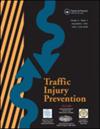Comparing alcohol involvement among injured pedalcycle and motorcycle riders across three national public-use datasets
IF 1.6
3区 工程技术
Q3 PUBLIC, ENVIRONMENTAL & OCCUPATIONAL HEALTH
引用次数: 0
Abstract
Background
Annually since 2008; over 38% of fatally injured motorcycle riders and 20% of pedalcyclists involved in traffic crashes were under the influence of alcohol, yet public health surveillance of alcohol involvement in these injuries is underdeveloped. This study determined alcohol involvement among fatally and non-fatally injured pedalcycle and motorcycle riders and compared findings across three national public-use datasets.
Methods
Using the 2019 National Emergency Medical Services Information System (NEMSIS), the Fatality Analysis Reporting System (FARS), and National Electronic Injury Surveillance System (NEISS) datasets, we identified alcohol involvement in fatal and non-fatal injuries to pedalcycle and motorcycle riders (≥21 years). Alcohol involvement was positive based on the clinician’s evaluation of alcohol at the scene (NEMSIS) or within the ED record (NEISS); or when Blood Alcohol Content (BAC) values were ≥.01 (FARS). Pedalcycle and motorcycle injuries were identified across datasets using: 1) ICD10 codes for pedalcycle (V10-V19) or motorcycle (V20-V29) within the cause of injury and EMS respondent’s impression of the encounter variables (NEMSIS); 2) product codes for bicycles or moped/power-assisted cycle/minibike/two-wheeled, powered, off-road vehicles (NEISS); and 3) American National Standard Institute’s classifications for pedalcycle and motorcycle in the person and vehicle type variables (FARS). The descriptive epidemiology was compared across datasets.
Results
There were 26,295 pedalcyclist and 50,122 motorcycle rider injuries resulting in an EMS response within NEMSIS data; 10.2% and 8.5% of these injuries respectively involved alcohol. These estimates were greater than the 7.3% of pedalcyclist and 6.1% of moped/power-assisted cycle/minibike/two-wheeled, powered, off-road vehicle injuries involving alcohol among patients who presented to an ED within the NEISS dataset. Based on FARS data, alcohol was involved in 27.0% of pedalcyclist and 42.0% of motorcyclist fatal injuries. Regardless of the data source, pedalcyclist and motorcycle fatal and non-fatal injuries were more likely to involve alcohol among middle-aged adults compared to older and early aged adults, and for men compared to women, with proportions that were generally 3-8% higher for men.
Conclusions
Measures for pedalcycle and motorcycle injuries and alcohol involvement vary substantially across national public-use datasets. Standardized, valid, and feasible methods are needed to accurately inform injury prevention efforts.
比较三个国家公共使用数据集中受伤的脚踏车和摩托车骑行者参与饮酒的情况。
背景:自 2008 年以来,每年都有超过 38% 的摩托车驾驶员和 20% 的踏板摩托车驾驶员在交通事故中受到酒精的影响,但对这些伤害中酒精参与情况的公共卫生监测还不够完善。本研究确定了受致命伤和非致命伤的脚踏车和摩托车骑行者中的酒精参与情况,并比较了三个国家公共使用数据集的调查结果:利用 2019 年国家紧急医疗服务信息系统 (NEMSIS)、死亡分析报告系统 (FARS) 和国家电子伤害监测系统 (NEISS) 数据集,我们确定了踏板车和摩托车骑行者(≥21 岁)致命和非致命伤中的酒精参与情况。根据临床医生对现场(NEMSIS)或急诊室记录(NEISS)中酒精含量的评估;或当血液酒精含量(BAC)值≥.01(FARS)时,酒精含量即为阳性。各数据集中的脚踏车和摩托车伤害是通过以下方法识别的:1) 在受伤原因和急救服务受访者对遭遇的印象变量(NEMSIS)中,脚踏摩托车(V10-V19)或摩托车(V20-V29)的 ICD10 编码;2) 自行车或轻便摩托车/助力车/两轮电动越野车(NEISS)的产品编码;3) 在人员和车辆类型变量(FARS)中,美国国家标准学会对脚踏摩托车和摩托车的分类。对不同数据集的描述性流行病学进行了比较:在 NEMSIS 数据中,有 26,295 起踏板摩托车驾驶员和 50,122 起摩托车驾驶员受伤导致急救响应;其中分别有 10.2% 和 8.5% 的受伤涉及酒精。这些估计值高于 NEISS 数据集中在急诊室就诊的患者中有 7.3% 的踏板摩托车手和 6.1% 的轻便摩托车/助力车/两轮电动越野车伤者涉及酒精的比例。根据 FARS 数据,27.0% 的踏板摩托车手和 42.0% 的摩托车手致命伤与酒精有关。无论数据来源如何,中年人与老年人和早年成年人相比,以及男性与女性相比,踏板车和摩托车致命和非致命伤更有可能涉及酒精,男性的比例一般高出 3-8%:结论:不同国家的公共使用数据集对脚踏车和摩托车伤害及涉及酒精的测量结果存在很大差异。我们需要标准化、有效且可行的方法来为伤害预防工作提供准确的信息。
本文章由计算机程序翻译,如有差异,请以英文原文为准。
求助全文
约1分钟内获得全文
求助全文
来源期刊

Traffic Injury Prevention
PUBLIC, ENVIRONMENTAL & OCCUPATIONAL HEALTH-
CiteScore
3.60
自引率
10.00%
发文量
137
审稿时长
3 months
期刊介绍:
The purpose of Traffic Injury Prevention is to bridge the disciplines of medicine, engineering, public health and traffic safety in order to foster the science of traffic injury prevention. The archival journal focuses on research, interventions and evaluations within the areas of traffic safety, crash causation, injury prevention and treatment.
General topics within the journal''s scope are driver behavior, road infrastructure, emerging crash avoidance technologies, crash and injury epidemiology, alcohol and drugs, impact injury biomechanics, vehicle crashworthiness, occupant restraints, pedestrian safety, evaluation of interventions, economic consequences and emergency and clinical care with specific application to traffic injury prevention. The journal includes full length papers, review articles, case studies, brief technical notes and commentaries.
 求助内容:
求助内容: 应助结果提醒方式:
应助结果提醒方式:


